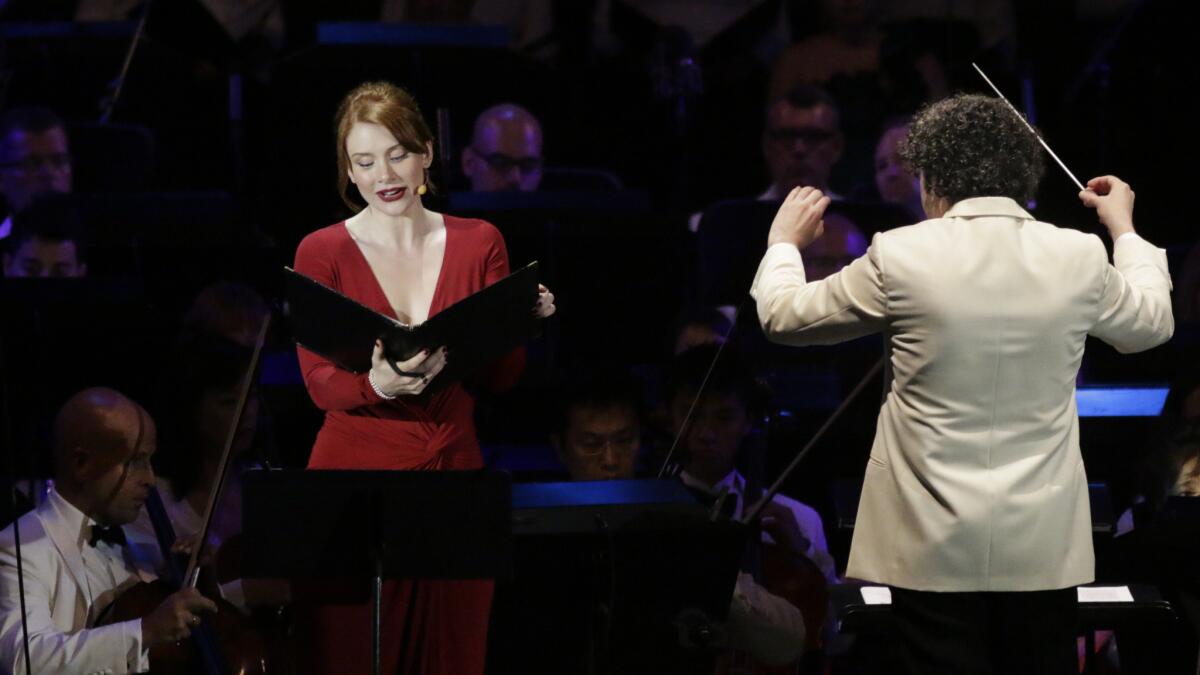Dudamel adds his dramatic touch to a night of Mendelssohn at Hollywood Bowl

Actress Bryce Dallas Howard narrates “A Midsummer Night’s Dream” as Gustavo Dudamel conducts the Los Angeles Philharmonic through Mendelssohn’s incidental music.
- Share via
The novelty of Gustavo Dudamel’s four Los Angeles Philharmonic programs at the Hollywood Bowl this summer is that each is devoted to a single composer, with one slight exception.
Last week brought a sensational performance of Carl Orff’s “Carmina Burana” (introduced by two short choral pieces by Eric Whitacre) and the Tchaikovsky Spectacular. He ends Thursday with Mozart. Dudamel takes to these composers as a duck does to water.
But with Mendelssohn, Dudamel is more like an amphibian taking to air. He is comfortable in the environment but also ever so slightly foreign. As if coming from the depths, he bathes in and is buoyed by the magic of the light but is not of the light.
Such is hardly unusual with conductors Dudamel’s age. Certain composers can prove for a while elusive. At 34, Leonard Bernstein was already the most marvelous of Haydn conductors, but only 20 years later was he able to unearth the essence of Mozart.
SIGN UP for the free Essential Arts & Culture newsletter >>
On one level Dudamel took no chances Tuesday. He relied on Mendelssohn’s two most beloved pieces: the Violin Concerto, with Gil Shaham as the winning soloist, and the incidental music to “A Midsummer Night’s Dream.” The latter had the added attractions of a Hollywood star, actress Bryce Dallas Howard, and atmospheric projections on the shell and the screens by director and video artist Alberto Arvelo.
There were moments of genuine Mendelssohnian enchantment all night. Dudamel knows what he is doing. He conducted the Violin Concerto from memory, and he ignored the physical score on the stand for the more famous moments in “Midsummer Night’s Dream.” The Overture began with ethereal grace. The Wedding March was inspiring enough that had Tiffany set up a stand on the way out of the Bowl, the jeweler might have unloaded a good number of gold rings. The Scherzo dazzled.
That alone, to say nothing of Dudamel’s alert accompaniment to Shaham’s mercurial playing, might be enough for any summer eve. The special moments revealed that Dudamel does indeed have the capacity for capturing the magic of Mendelssohn. But he also seems to want more from the composer than the surface splendor wherein the greatest wonder of Mendelssohn lies.
In the Violin Concerto, the pleasures were straightforward. Shaham brought his gleaming tone and his boyish charm. You could see him prepare for a virtuoso passage as a high jumper might for a leap. The video screens showed the exhilaration on his face as he then met the challenge.
Dudamel looked to have just as much fun egging on his soloist, although the orchestral playing itself at times became heavy, unless that was surplus sonic grain added by the amplification.
There is history to “A Midsummer Night’s Dream” at the Bowl. Max Reinhardt’s 1934 elaborately staged production of it with Mendelssohn’s music and Hollywood stars is maybe the Bowl’s most celebrated occasion. That led to Reinhardt’s classic film made the next year. Eleven years ago, the L.A. Phil inaugurated the new Bowl shell with the Mendelssohn and production of the play by A Noise Within.
Arvelo paid homage to Reinhardt by including footage of the film’s fairy ballet, although curiously transferring that to the Wedding March. Otherwise, Arvelo effectively illuminated the shell with projected dewdrops and leaves. He switched back and forth on the monitors between showing the orchestra or Howard and kitschy Victorian animations.
Howard read portions of Shakespeare with more emphasis on text than character. Strident as Puck and affectionately caustic as Oberon, she put on an amusing Cockney accent for Bottom.
But the best acting came from Dudamel. His tendency to put more drama in Mendelssohn than the music can sustain may not have given him enough room for the eloquent sentimentality that is the most remarkable aspect of this score. But Dudamel’s ability to find the dramatic flavor of individual moments with his vividly communicative facial expressions could be acting on a very high level. A curl of the conductor’s lip to encourage a humorous bassoon fillip when shown in close-up on the video screen got a greater audience response than any line delivered by Howard.
In the end, this “Midsummer Night’s Dream” had the aspect of something quickly thrown together. The small contributions of soprano Deanna Breiwick, mezzo-soprano Jennifer Holloway and women of the Los Angeles Master Chorale were capable. The Bowl is no longer the sylvan setting it once was, and massive productions like Reinhardt’s are no longer physically or financially feasible. But much of Arvelo’s visual imagery seemed like vamping.
This is a score that Dudamel will no doubt come back to. When all of it works as well as the best of it worked Tuesday, it will become a wonder.
Twitter: @markswed
More to Read
The biggest entertainment stories
Get our big stories about Hollywood, film, television, music, arts, culture and more right in your inbox as soon as they publish.
You may occasionally receive promotional content from the Los Angeles Times.











